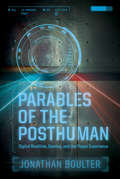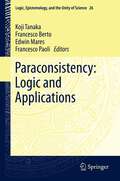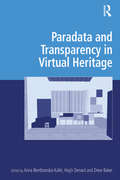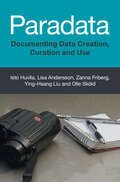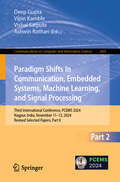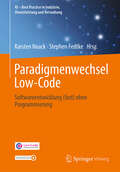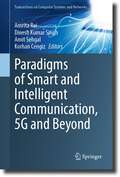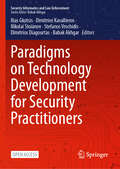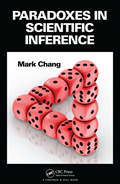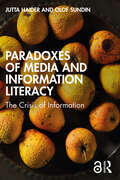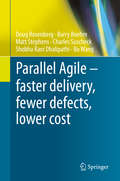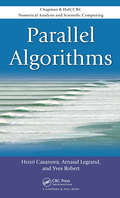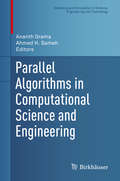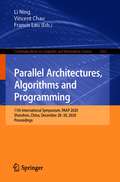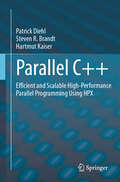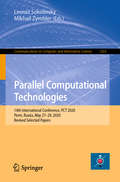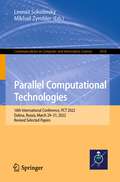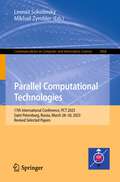- Table View
- List View
Parables of the Posthuman: Digital Realities, Gaming, and the Player Experience (Contemporary Approaches to Film and Media Series)
by Jonathan BoulterIn its intimate joining of self and machine, video gaming works to extend the body into a fluid, dynamic, unstable, and discontinuous entity. While digital gaming and culture has become a popular field of academic study, there has been a lack of sustained philosophical analysis of this direct gaming experience. In Parables of the Posthuman: Digital Realities, Gaming, and the Player Experience, author Jonathan Boulter addresses this gap by analyzing video games and the player experience philosophically. Finding points of departure in phenomenology and psychoanalysis, Boulter argues that we need to think seriously about what it means to enter into a relationship with the game machine and to assume (or to have conferred upon you) a machinic, posthuman identity. Parables of the Posthuman approaches the experience of gaming by asking: What does it mean for the player to enter the machinic "world" of the game? What forms of subjectivity does the game offer to the player? What happens to consciousness itself when one plays? To this end, Boulter analyzes the experience of particular role-playing video games, including Fallout 3, Half-Life 2, Bioshock, Crysis 2, and Metal Gear Solid 4. These games both thematize the idea of the posthuman--the games are "about" subjects whose physical and intellectual capacities are extended through machine or other prosthetic means--and also enact an experience of the posthuman for the player, who becomes more than what he was as he plays the game. Boulter concludes by exploring how the game acts as a parable of what the human, or posthuman, may look like in times to come. Academics with an interest in the intersection of philosophy, psychoanalysis, and popular culture forms and video gamers with an interest in thinking about the implications of gaming will enjoy this volume.
Paraconsistency: Logic and Applications
by Francesco Berto Edwin Mares Francesco Paoli Koji TanakaA logic is called 'paraconsistent' if it rejects the rule called 'ex contradictione quodlibet', according to which any conclusion follows from inconsistent premises. While logicians have proposed many technically developed paraconsistent logical systems and contemporary philosophers like Graham Priest have advanced the view that some contradictions can be true, and advocated a paraconsistent logic to deal with them, until recent times these systems have been little understood by philosophers. This book presents a comprehensive overview on paraconsistent logical systems to change this situation. The book includes almost every major author currently working in the field. The papers are on the cutting edge of the literature some of which discuss current debates and others present important new ideas. The editors have avoided papers about technical details of paraconsistent logic, but instead concentrated upon works that discuss more "big picture" ideas. Different treatments of paradoxes takes centre stage in many of the papers, but also there are several papers on how to interpret paraconistent logic and some on how it can be applied to philosophy of mathematics, the philosophy of language, and metaphysics.
Paraconsistent Intelligent-Based Systems
by Jair Minoro AbeThis book presents some of the latest applications of new theories based on the concept of paraconsistency and correlated topics in informatics, such as pattern recognition (bioinformatics), robotics, decision-making themes, and sample size. Each chapter is self-contained, and an introductory chapter covering the logic theoretical basis is also included. The aim of the text is twofold: to serve as an introductory text on the theories and applications of new logic, and as a textbook for undergraduate or graduate-level courses in AI. Today AI frequently has to cope with problems of vagueness, incomplete and conflicting (inconsistent) information. One of the most notable formal theories for addressing them is paraconsistent (paracomplete and non-alethic) logic.
Paradata and Transparency in Virtual Heritage (Digital Research in the Arts and Humanities)
by Anna Bentkowska-Kafel Hugh Denard Drew BakerComputer-Generated Images (CGIs) are widely used and accepted in the world of entertainment but the use of the very same visualization techniques in academic research in the Arts and Humanities remains controversial. The techniques and conceptual perspectives on heritage visualization are a subject of an ongoing interdisciplinary debate. By demonstrating scholarly excellence and best technical practice in this area, this volume is concerned with the challenge of providing intellectual transparency and accountability in visualization-based historical research. Addressing a range of cognitive and technological challenges, the authors make a strong case for a wider recognition of three-dimensional visualization as a constructive, intellectual process and valid methodology for historical research and its communication. Intellectual transparency of visualization-based research, the pervading theme of this volume, is addressed from different perspectives reflecting the theory and practice of respective disciplines. The contributors - archaeologists, cultural historians, computer scientists and ICT practitioners - emphasize the importance of reliable tools, in particular documenting the process of interpretation of historical material and hypotheses that arise in the course of research. The discussion of this issue refers to all aspects of the intellectual content of visualization and is centred around the concept of 'paradata'. Paradata document interpretative processes so that a degree of reliability of visualization outcomes can be understood. The disadvantages of not providing this kind of intellectual transparency in the communication of historical content may result in visual products that only convey a small percentage of the knowledge that they embody, thus making research findings not susceptible to peer review and rendering them closed to further discussion. It is argued, therefore, that paradata should be recorded alongside more tangible outcomes of research, preferably as an integral part of virtual models, and sustained beyond the life-span of the technology that underpins visualization.
Paradata: Documenting Data Creation, Curation and Use
by Isto Huvila Ying-Hsang Liu Lisa Andersson Olle Sköld Zanna FribergTo make sense of data and use it effectively, it is essential to know where it comes from and how it has been processed and used. This is the domain of paradata, an emerging interdisciplinary field with wide applications. As digital data rapidly accumulates in repositories worldwide, this comprehensive introductory book, the first of its kind, shows how to make that data accessible and reusable. In addition to covering basic concepts of paradata, the book supports practice with coverage of methods for generating, documenting, identifying and managing paradata, including formal metadata, narrative descriptions and qualitative and quantitative backtracking. The book also develops a unifying reference model to help readers contextualise the role of paradata within a wider system of knowledge, practices and processes, and provides a vision for the future of the field. This guide to general principles and practice is ideal for researchers, students and data managers. This title is also available as open access on Cambridge Core.
Paradigm Shift: The New Promise of Information Technology
by Don Tapscott Art CastonThe old, unresponsive bureaucracy simply doesn't work in today's volatile, open, global business environment. However, the computing systems in today's organization seem unable to deliver the goods for corporate rebirth.
Paradigm Shifts in Communication, Embedded Systems, Machine Learning, and Signal Processing: Third International Conference, PCEMS 2024, Nagpur, India, November 11–12, 2024, Revised Selected Papers, Part I (Communications in Computer and Information Science #2490)
by Deep Gupta Vipin Kamble Vishal Satpute Ashwin KothariThis two-volume set CCIS 2490-2491 constitutes the refereed proceedings of the Third International Conference on Paradigm Shifts in Communication, Embedded Systems, Machine Learning, and Signal Processing, PCEMS 2024, held in Nagpur, India, during November 11–12, 2024.The 73 full papers and 17 short papers presented in this volume were carefully reviewed and selected from 330 submissions. The papers present recent research in the areas of communication, antenna, computer vison, medical image analysis, deep learning, AI based systems and applications, classification problem, embedded system and IoT, etc.
Paradigm Shifts in Communication, Embedded Systems, Machine Learning, and Signal Processing: Third International Conference, PCEMS 2024, Nagpur, India, November 11–12, 2024, Revised Selected Papers, Part II (Communications in Computer and Information Science #2491)
by Deep Gupta Vipin Kamble Vishal Satpute Ashwin KothariThis two-volume set CCIS 2490-2491 constitutes the refereed proceedings of the Third International Conference on Paradigm Shifts in Communication, Embedded Systems, Machine Learning, and Signal Processing, PCEMS 2024, held in Nagpur, India, during November 11–12, 2024.The 73 full papers and 17 short papers presented in this volume were carefully reviewed and selected from 330 submissions. The papers present recent research in the areas of communication, antenna, computer vison, medical image analysis, deep learning, AI based systems and applications, classification problem, embedded system and IoT, etc.
Paradigmenwechsel Low-Code: Softwareentwicklung (fast) ohne Programmierung (KI – Best Practice in Industrie, Dienstleistung und Verwaltung)
by Stephen Fedtke Karsten NoackDas Buch bietet als bislang einziges Standardwerk einen umfassenden und herstellerneutralen Überblick über die Ursprünge, Funktionsweisen und Möglichkeiten, über Einsatzszenarien und Perspektiven von Low-Code- und No-Code-Technologien. Es bietet hierbei einen praxisbezogenen Leitfaden für Auswahl, Implementierung und Einsatz passender Low-Code-Lösungen. Das Buch ist deshalb von besonderer Wichtigkeit, weil Low-Code die Welt der Softwareentwicklung wie kaum eine andere Innovation der letzten Jahrzehnte verändern wird, und das in einer kaum überblickbaren Breite und Vielfalt. Es bietet den notwendigen Überblick sowie Einsatzszenarien, objektive Einschätzung und Bewertung unterschiedlicher Low-Code-Lösungen. Das Buch bietet damit eine fundamentale Entscheidungshilfe für die relevanten IT-Strategen und IT-Manager. Hauptzielgruppe: IT-Verantwortliche in Wirtschaft, Organisationen aller Art und Verwaltung, d.h. CIOs, CDOs, CTOs, IT-Verantwortliche und deren gesamter Mitarbeiterstab.Projektverantwortliche von IT-Projekten in den Fachbereichen in Wirtschaft, Organisationen aller Art, sowie Verwaltung und Management von Softwareherstellern und IT-Dienstleistern, unabhängig von Art und Größe.Berater, Projektmanager und Experten für IT- und Digitalisierungsstrategien, einschl. Pressevertreter, Blogger u.dgl.KI- und Sicherheitsexperten, die sich ihren Aspekt im Bereich Low-Code interessieren
Paradigms of Smart and Intelligent Communication, 5G and Beyond (Transactions on Computer Systems and Networks)
by Korhan Cengiz Amrita Rai Dinesh Kumar Singh Amit SehgalThis book focuses on both theory and applications of Artificial Intelligence and Machine Learning in the broad areas of communication and networking. This book focuses on the ongoing research work and future scope for various open research issues related to sustainable design, development, and analysis of smart communication, 5G and beyond, with the integration of Artificial intelligence and IoT. It addresses fundamental technology components for 5G and beyond, which include modern advancements in communication and networking in a real-world application. The book presents the convergence of Artificial Intelligence, Machine Learning, and IoT with 5G and beyond wireless networks to give some ice-breaking solutions in radio resource allocation, network management, and cybersecurity. This book will be a valuable resource for academicians, researchers, and professionals working in artificial intelligence/machine learning and its applications in communication and 5G.
Paradigms on Technology Development for Security Practitioners (Security Informatics and Law Enforcement)
by Babak Akhgar Stefanos Vrochidis Dimitrios Kavallieros Nikolai Stoianov Ilias Gkotsis Dimitrios DiagourtasThis open access book is authored by a rich mix of contributors from across the landscape of research, academia, LEAs, civil protection, and other first responders, practitioners, public and private organizations and industry to address some of the most contemporary challenges within global security domain. The authors cover topics such as protection of critical infrastructures (CI), serious and organized crime, counter (cyber) terrorism, border management, cybercrime, cybersecurity, management of disasters and crises, big data analytics, the application of AI and the legal and ethical dimensions of the implementation of cutting-edge technologies. The book benefits from research actions and lessons learned from more than 35 EU R&D projects within the security domain. The book not only addresses theoretical narratives pertinent to the subject but also identifies current challenges and emerging security threats, provides analysis of operational capability gaps, real world applied solutions, methodologies, and case studies within security domain. This is an open access book.
Paradoxes in Scientific Inference
by Mark ChangParadoxes are poems of science and philosophy that collectively allow us to address broad multidisciplinary issues within a microcosm. A true paradox is a source of creativity and a concise expression that delivers a profound idea and provokes a wild and endless imagination. The study of paradoxes leads to ultimate clarity and, at the same time, in
Paradoxes of Media and Information Literacy: The Crisis of Information
by Jutta Haider Olof SundinParadoxes of Media and Information Literacy contributes to ongoing conversations about control of knowledge and different ways of knowing. It does so by analysing why media and information literacy (MIL) is proposed as a solution for addressing the current information crisis. Questioning why MIL is commonly believed to wield such power, the book throws into sharp relief several paradoxes that are built into common understandings of such literacies. Haider and Sundin take the reader on a journey across different fields of practice, research and policymaking, including librarianship, information studies, teaching and journalism, media and communication and the educational sciences. The authors also consider national information policy proposals and the recommendations of NGOs or international bodies, such as UNESCO and the OECD. Showing that MIL plays an active role in contemporary controversies, such as those on climate change or vaccination, Haider and Sundin argue that such controversies challenge existing notions of fact and ignorance, trust and doubt, and our understanding of information access and information control. The book thus argues for the need to unpack and understand the contradictions forming around these notions in relation to MIL, rather than attempting to arrive at a single, comprehensive definition. Paradoxes of Media and Information Literacy combines careful analytical and conceptual discussions with an in-depth understanding of information practices and of the contemporary information infrastructure. It is essential reading for scholars and students engaged in library and information studies, media and communication, journalism studies and the educational sciences.
Parallel Agile – faster delivery, fewer defects, lower cost
by Bo Wang Barry Boehm Doug Rosenberg Matt Stephens Charles Suscheck Shobha Rani DhalipathiFrom the beginning of software time, people have wondered why it isn’t possible to accelerate software projects by simply adding staff. This is sometimes known as the “nine women can’t make a baby in one month” problem. The most famous treatise declaring this to be impossible is Fred Brooks’ 1975 book The Mythical Man-Month, in which he declares that “adding more programmers to a late software project makes it later,” and indeed this has proven largely true over the decades. Aided by a domain-driven code generator that quickly creates database and API code, Parallel Agile (PA) achieves significant schedule compression using parallelism: as many developers as necessary can independently and concurrently develop the scenarios from initial prototype through production code. Projects can scale by elastic staffing, rather than by stretching schedules for larger development efforts. Schedule compression with a large team of developers working in parallel is analogous to hardware acceleration of compute problems using parallel CPUs. PA has some similarities with and differences from other Agile approaches. Like most Agile methods, PA "gets to code early" and uses feedback from executable software to drive requirements and design. PA uses technical prototyping as a risk-mitigation strategy, to help sanity-check requirements for feasibility, and to evaluate different technical architectures and technologies. Unlike many Agile methods, PA does not support "design by refactoring," and it doesn't drive designs from unit tests. Instead, PA uses a minimalist UML-based design approach (Agile/ICONIX) that starts out with a domain model to facilitate communication across the development team, and partitions the system along use case boundaries, which enables parallel development. Parallel Agile is fully compatible with the Incremental Commitment Spiral Model (ICSM), which involves concurrent effort of a systems engineering team, a development team, and a test team working alongside the developers. The authors have been researching and refining the PA process for several years on multiple test projects that have involved over 200 developers. The book’s example project details the design of one of these test projects, a crowdsourced traffic safety system.
Parallel Algorithms (Chapman & Hall/CRC Numerical Analysis and Scientific Computing Series)
by Yves Robert Henri Casanova Arnaud LegrandFocusing on algorithms for distributed-memory parallel architectures, Parallel Algorithms presents a rigorous yet accessible treatment of theoretical models of parallel computation, parallel algorithm design for homogeneous and heterogeneous platforms, complexity and performance analysis, and essential notions of scheduling. The book extract
Parallel Algorithms in Computational Science and Engineering (Modeling and Simulation in Science, Engineering and Technology)
by Ananth Grama Ahmed H. SamehThis contributed volume highlights two areas of fundamental interest in high-performance computing: core algorithms for important kernels and computationally demanding applications. The first few chapters explore algorithms, numerical techniques, and their parallel formulations for a variety of kernels that arise in applications. The rest of the volume focuses on state-of-the-art applications from diverse domains. By structuring the volume around these two areas, it presents a comprehensive view of the application landscape for high-performance computing, while also enabling readers to develop new applications using the kernels. Readers will learn how to choose the most suitable parallel algorithms for any given application, ensuring that theory and practicality are clearly connected. Applications using these techniques are illustrated in detail, including:Computational materials science and engineeringComputational cardiovascular analysisMultiscale analysis of wind turbines and turbomachineryWeather forecastingMachine learning techniquesParallel Algorithms in Computational Science and Engineering will be an ideal reference for applied mathematicians, engineers, computer scientists, and other researchers who utilize high-performance computing in their work.
Parallel Architectures, Algorithms and Programming: 10th International Symposium, PAAP 2019, Guangzhou, China, December 12–14, 2019, Revised Selected Papers (Communications in Computer and Information Science #1163)
by Hong Shen Yingpeng SangThis book constitutes the refereed proceedings of the 10th International Symposium on Parallel Architectures, Algorithms and Programming, PAAP 2019, held in Guangzhou, China, in December 2019.The 39 revised full papers and 8 revised short papers presented were carefully reviewed and selected from 121 submissions. The papers deal with research results and development activities in all aspects of parallel architectures, algorithms and programming techniques.
Parallel Architectures, Algorithms and Programming: 11th International Symposium, PAAP 2020, Shenzhen, China, December 28–30, 2020, Proceedings (Communications in Computer and Information Science #1362)
by Francis Lau Li Ning Vincent ChauThis book constitutes the refereed proceedings of the 11th International Symposium on Parallel Architectures, Algorithms and Programming, PAAP 2020, held in Shenzhen, China, in December 2020.The 37 revised full papers presented were carefully reviewed and selected from 75 submissions. The papers deal with research results and development activities in all aspects of parallel architectures, algorithms and programming techniques.
Parallel C++: Efficient and Scalable High-Performance Parallel Programming Using HPX
by Patrick Diehl Hartmut Kaiser Steven R. BrandtThis textbook focuses on practical parallel C++ programming at the graduate student level. In particular, it shows the APIs and related language features in the C++ 17 and C++ 20 standards, covering both single node and distributed systems. It shows that with the parallel features in the C++ 17 and C++ 20 standards, learning meta-languages like OpenMP is no longer necessary. Using the C++ standard library for parallelism and concurrency (HPX), the same language features can be extended to distributed codes, providing a higher-level C++ interface to distributed programming than the Message Passing Interface (MPI). The book starts with the single-threaded implementation of the fractal sets, e.g. Julia set, and Mandelbrot set, using the C++ Standard Library (SL)’s container and algorithms. This code base is used for parallel implementation using low-level threads, asynchronous programming, parallel algorithms, and coroutines. The asynchronous programming examples are then extended to distributed programming using the C++ standard library for parallelism and concurrency (HPX). Octo-Tiger, an astrophysics code for stellar merger, is used as a showcase for a portable, efficient, and scalable high-performance application using HPX. The book’s core audience is advanced undergraduate and graduate students who want to learn the basics of parallel and distributed C++ programming but are not computer science majors. Basic C++ knowledge, like functions, classes, loops, and conditional statements, is assumed as a requirement, while C++ advanced topics, like generic programming, lambda functions, smart pointers, and move semantics, are briefly summarized in the appendix.
Parallel Computational Technologies: 11th International Conference, Pct 2017, Kazan, Russia, April 3-7, 2017, Revised Selected Papers (Communications In Computer And Information Science #753)
by Leonid Sokolinsky Mikhail ZymblerThis book constitutes the refereed proceedings of the 12th International Conference on Parallel Computational Technologies, PCT 2018, held in Rostov-on-Don, Russia, in April 2018.The 24 revised full papers presented were carefully reviewed and selected from 167 submissions. The papers are organized in topical sections on high performance architectures, tools and technologies; parallel numerical algorithms; supercomputer simulation.
Parallel Computational Technologies: 13th International Conference, PCT 2019, Kaliningrad, Russia, April 2–4, 2019, Revised Selected Papers (Communications in Computer and Information Science #1063)
by Leonid Sokolinsky Mikhail ZymblerThis book constitutes the refereed proceedings of the 13th International Conference on Parallel Computational Technologies, PCT 2019, held in Kaliningrad, Russia, in April 2019.The 24 revised full papers presented were carefully reviewed and selected from 96 submissions. The papers are organized in topical sections on high performance architectures, tools and technologies; parallel numerical algorithms; supercomputer simulation.
Parallel Computational Technologies: 14th International Conference, PCT 2020, Perm, Russia, May 27–29, 2020, Revised Selected Papers (Communications in Computer and Information Science #1263)
by Leonid Sokolinsky Mikhail ZymblerThis book constitutes refereed proceedings of the 14th International Conference on Parallel Computational Technologies, PCT 2020, held in May 2020. Due to the COVID-19 pandemic the conference was held online.The 22 revised full papers and 2 short papers presented were carefully reviewed and selected from 124 submissions. The papers are organized in topical sections on high performance architectures, tools and technologies; parallel numerical algorithms; supercomputer simulation.
Parallel Computational Technologies: 15th International Conference, PCT 2021, Volgograd, Russia, March 30 – April 1, 2021, Revised Selected Papers (Communications in Computer and Information Science #1437)
by Leonid Sokolinsky Mikhail ZymblerThis book constitutes refereed proceedings of the 15th International Conference on Parallel Computational Technologies, PCT 2021, held in March-April 2021. Due to the COVID-19 pandemic the conference was held online. The 22 revised full papers presented were carefully reviewed and selected from 89 submissions. The papers are organized in topical sections on high performance architectures, tools and technologies; parallel numerical algorithms; supercomputer simulation.
Parallel Computational Technologies: 16th International Conference, PCT 2022, Dubna, Russia, March 29–31, 2022, Revised Selected Papers (Communications in Computer and Information Science #1618)
by Leonid Sokolinsky Mikhail ZymblerThis book constitutes the refereed proceedings of the 16th International Conference on Parallel Computational Technologies, PCT 2022, held in Dubna, Russia, during March 29–31, 2022.The 22 full papers included in this book were carefully reviewed and selected from 60 submissions. They were organized in topical sections as follows: high performance architectures, tools and technologies; parallel numerical algorithms; supercomputer simulation.
Parallel Computational Technologies: 17th International Conference, PCT 2023, Saint Petersburg, Russia, March 28–30, 2023, Revised Selected Papers (Communications in Computer and Information Science #1868)
by Leonid Sokolinsky Mikhail ZymblerThis book constitutes the refereed post proceedings of the 17th International Conference on Parallel Computational Technologies, PCT 2023, held in Saint Petersburg, Russia, during March 28–30, 2023.The 25 full papers included in this book were carefully reviewed and selected from 71 submissions. They were organized in topical sections as follows: "High Performance Architectures, Tools and Technologies", "Parallel Numerical Algorithms", and "Supercomputer Simulation".
